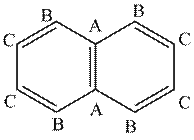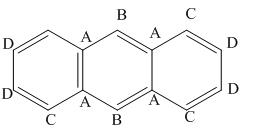
Concept explainers
How many
a.  b
b . c.
. c.  d.
d. 
(a)
Interpretation: The number of
Concept introduction: The
Answer to Problem 17.53P
The number of
Explanation of Solution
The
The given compound contains five different types of carbon atoms as follows.

Figure 1
Thus, the number of
The number of
(b)
Interpretation: The number of
Concept introduction: The
Answer to Problem 17.53P
The number of
Explanation of Solution
The
The given compound contains nine different types of carbon atoms as follows.

Figure 2
Thus, the number of
The number of
(c)
Interpretation: The number of
Concept introduction: The
Answer to Problem 17.53P
The number of
Explanation of Solution
The
The given compound contains three different types of carbon atoms as follows.

Figure 3
Thus, the number of
The number of
(d)
Interpretation: The number of
Concept introduction: The
Answer to Problem 17.53P
The number of
Explanation of Solution
The
The given compound contains four different types of carbon atoms as follows.

Figure 4
Thus, the number of
The number of
Want to see more full solutions like this?
Chapter 17 Solutions
ORG.CHEMISTRY W/ACCESS+MODEL KIT PKG
- Answer the following questions for each compound: a. How many signals are in its 13C NMR spectrum? b. Which signal is at the lowest frequency?arrow_forwardConsider geraniol, the principal constituent of rose oil.a.How many 1H NMR signals does geraniol exhibit? b.How many 13C NMR signals does geraniol exhibit? c.Into how many peaks will the protons on each C=C be split?arrow_forwardConsider geraniol, the principal constituent of rose oil. a.) How many 1H NMR signals does geraniol exhibit? b.) How many 13C NMR signals does geraniol exhibit?c.) Into how many peaks will the protons on each C=C be split?arrow_forward
 ChemistryChemistryISBN:9781305957404Author:Steven S. Zumdahl, Susan A. Zumdahl, Donald J. DeCostePublisher:Cengage Learning
ChemistryChemistryISBN:9781305957404Author:Steven S. Zumdahl, Susan A. Zumdahl, Donald J. DeCostePublisher:Cengage Learning ChemistryChemistryISBN:9781259911156Author:Raymond Chang Dr., Jason Overby ProfessorPublisher:McGraw-Hill Education
ChemistryChemistryISBN:9781259911156Author:Raymond Chang Dr., Jason Overby ProfessorPublisher:McGraw-Hill Education Principles of Instrumental AnalysisChemistryISBN:9781305577213Author:Douglas A. Skoog, F. James Holler, Stanley R. CrouchPublisher:Cengage Learning
Principles of Instrumental AnalysisChemistryISBN:9781305577213Author:Douglas A. Skoog, F. James Holler, Stanley R. CrouchPublisher:Cengage Learning Organic ChemistryChemistryISBN:9780078021558Author:Janice Gorzynski Smith Dr.Publisher:McGraw-Hill Education
Organic ChemistryChemistryISBN:9780078021558Author:Janice Gorzynski Smith Dr.Publisher:McGraw-Hill Education Chemistry: Principles and ReactionsChemistryISBN:9781305079373Author:William L. Masterton, Cecile N. HurleyPublisher:Cengage Learning
Chemistry: Principles and ReactionsChemistryISBN:9781305079373Author:William L. Masterton, Cecile N. HurleyPublisher:Cengage Learning Elementary Principles of Chemical Processes, Bind...ChemistryISBN:9781118431221Author:Richard M. Felder, Ronald W. Rousseau, Lisa G. BullardPublisher:WILEY
Elementary Principles of Chemical Processes, Bind...ChemistryISBN:9781118431221Author:Richard M. Felder, Ronald W. Rousseau, Lisa G. BullardPublisher:WILEY





